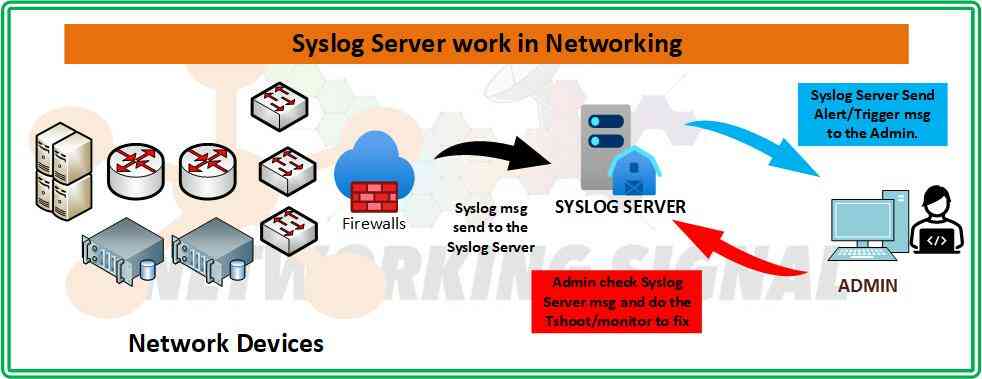What is Syslog in Networking?
Syslog is a protocol for logging system events on network devices such as routers, switches, and firewalls. It provides a centralized method of collecting log data from multiple networking devices, which can then be used to track activity and identify potential problems.
Syslog messages can range from simple informational messages about router activity to security alerts about malicious activity. The protocol is widely used in IT departments to monitor devices, detect security threats, and troubleshoot network issues.
What is Syslog Message Format?
Syslog messages have a specific format that includes the following components:
- A priority value indicates the severity of the message.
- The source of the message and its time and date stamp.
- The hostname or IP address of the device generating the message.
- The application or process name is associated with the message.
- The message itself.
How Does Syslog Works?

The working process of Syslog involves the following steps:
- A network device generates a Syslog message and sends it to the Syslog server.
- The Syslog server receives the message and stores it in its log file.
- An administrator can view the messages in an interface such as a web browser or command line tool.
- The administrator can then use the messages to analyze and troubleshoot network issues, track activity, or identify potential security threats.
Example of Syslog and How to Use in Networking?
Syslog messages can be used for a variety of purposes, including:
- Tracking user activity: Syslog messages can help administrators track and analyze user activity on the network.
- Detecting security threats: Network devices generate Syslog messages when suspicious or malicious activity is detected. These messages can alert administrators to investigate further.
- Troubleshooting network issues: Syslog messages can provide valuable information about the source of a problem and help administrators identify the cause.
What are the Benefits of Syslog?
The main benefits of Syslog are:
- Centralized log storage: Syslog provides a central location for all log data, making it easier to analyze and track activity.
- Automation: Syslog messages can be sent automatically when certain conditions are met, allowing administrators to receive alerts quickly.
- Security: Syslog can be used to detect and alert administrators of potential security threats.
- Cost savings: By consolidating log data in one place, Syslog helps reduce IT costs by eliminating the need for multiple logging systems.
How to Build and Configure Syslog Server?

Building and Configuring Syslog Server on a network device involves the following steps:
- Create a Syslog server by installing the necessary software onto a computer or virtual machine.
- Configure the Syslog server to accept messages from your network devices.
- Log into each of your network devices and configure them to send Syslog messages to the Syslog server.
- Test and verify that the messages are being sent successfully.
- Monitor your network devices for any suspicious or malicious activity and investigate any potential threats.
Tips For Configuring Syslog on Network Devices
- Use a secure protocol such as TLS or SSH for sending Syslog messages across the network.
- Configure your devices to log only relevant information that will be useful in monitoring and troubleshooting activities.
- Avoid sending too much data, as this could overwhelm the Syslog server and cause performance issues.
- Regularly audit your log files for any suspicious activity.
- Use filtering and alerting rules to quickly identify potential threats.
- Make sure the Syslog server is regularly backed up to avoid data loss in case of an emergency.
- Consider using a third-party Syslog management solution to simplify the process and enhance security.
How to Troubleshoot Syslog Issues?
If you are having trouble with Syslog messages not being received or logged correctly, here are some troubleshooting tips:
- Check the configuration of your network devices to make sure they are sending Syslog data to the correct IP address.
- Verify that there is no firewall blocking the Syslog traffic.
- Ensure that the Syslog server is configured to receive messages from your network devices.
- Check for any discrepancies between the date and time on your network devices and the Syslog server.
- Make sure you have enough disk space available on the Syslog server to store all of the log data.
- Check the log file on the Syslog server to see if any messages have been received.
- Try restarting the Syslog server and network devices to clear any possible errors.
- If all else fails, consider using a third-party Syslog management solution to provide additional support.
What is the Future of Syslog?
Syslog is a mature technology that has been around for decades, and it continues to be used in modern networks. As networks become more complex, the need for reliable and secure logging solutions increases. The use of Syslog is expected to grow as organizations move towards cloud-native architectures and digital transformation initiatives.
Additionally, advances in Artificial Intelligence and Machine Learning are expected to improve the capabilities of Syslog, making it a powerful tool for managing large-scale IT environments. In the future, Syslog is likely to become even more important in ensuring security and compliance requirements are met.

